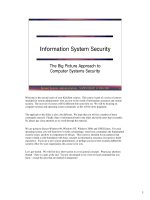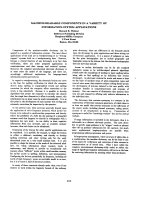Information system ralph CH01
Bạn đang xem bản rút gọn của tài liệu. Xem và tải ngay bản đầy đủ của tài liệu tại đây (905.79 KB, 67 trang )
About the Presentations
• The presentations cover the objectives found in the
opening of each chapter.
• All chapter objectives are listed in the beginning of
each presentation.
• You may customize the presentations to fit your
class needs.
• Some figures from the chapters are included. A
complete set of images from the book can be found
on the Instructor Resources disc.
Fundamentals of Information
Systems, Fifth Edition
Chapter 1
An Introduction to Information Systems
in Organizations
Principles and Learning Objectives
• The value of information is directly linked to how it
helps decision makers achieve the organization’s
goals
– Distinguish data from information and describe the
characteristics used to evaluate the value of data
Fundamentals of Information Systems, Fifth Edition
3
Principles and Learning Objectives
(continued)
• Knowing the potential impact of information
systems and having the ability to put this
knowledge to work can result in a successful
personal career and organizations that reach their
goals
– Identify the basic types of business information
systems and discuss who uses them, how they are
used, and what kinds of benefits they deliver
Fundamentals of Information Systems, Fifth Edition
4
Principles and Learning Objectives
(continued)
• System users, business managers, and information
systems professionals must work together to build
a successful information system
– Identify the major steps of the systems development
process and state the goal of each
Fundamentals of Information Systems, Fifth Edition
5
Principles and Learning Objectives
(continued)
• The use of information systems to add value to the
organization can also give an organization a
competitive advantage
– Identify the value-added processes in the supply
chain and describe the role of information systems
within them
– Identify some of the strategies employed to lower
costs or improve service
– Define the term competitive advantage and discuss
how organizations are using information systems to
gain such an advantage
Fundamentals of Information Systems, Fifth Edition
6
Principles and Learning Objectives
(continued)
• Cooperation between business managers and IS
personnel is the key to unlocking the potential of
any new or modified system
– Define the types of roles, functions, and careers
available in information systems
Fundamentals of Information Systems, Fifth Edition
7
Information Concepts
• Data, information, and knowledge
– Data: raw facts
– Information: collection of facts organized in such a
way that they have additional value beyond the value
of the facts themselves
– Process: Set of logically related tasks performed to
achieve a defined outcome
– Knowledge: Awareness and understanding of a set
of information
Fundamentals of Information Systems, Fifth Edition
8
Fundamentals of Information Systems, Fifth Edition
9
Fundamentals of Information Systems, Fifth Edition
10
Fundamentals of Information Systems, Fifth Edition
11
The Characteristics of Valuable
Information
• If information is not accurate or complete
– People can make poor decisions, costing thousands,
or even millions, of dollars
• Information can be of little value to the organization
– If information is not relevant, not delivered to
decision makers in a timely fashion, or too complex
to understand
Fundamentals of Information Systems, Fifth Edition
12
Fundamentals of Information Systems, Fifth Edition
13
The Value of Information
• Valuable information
– Can help people and their organizations perform
tasks more efficiently and effectively
– Can help managers decide whether to invest in
additional information systems and technology
Fundamentals of Information Systems, Fifth Edition
14
What Is an Information System?
• Feedback mechanism
– The component that helps organizations achieve
their goals, such as increasing profits or improving
customer service
Fundamentals of Information Systems, Fifth Edition
15
Fundamentals of Information Systems, Fifth Edition
16
Input, Processing, Output, Feedback
• Input
– Gathering and capturing raw data
• Processing
– Converting or transforming data into useful outputs
• Output
– Production of useful information, usually in the form
of documents and reports
• Feedback
– Output that is used to make changes to input or
processing activities
Fundamentals of Information Systems, Fifth Edition
17
Manual and Computerized Information
Systems
• An information system can be:
– Manual
• Example: developing patterns and trends on graph
paper for stock analysis
– Computerized
• Example: using program trading to track the market
and trade large blocks of stocks when discrepancies
occur
Fundamentals of Information Systems, Fifth Edition
18
Computer-Based Information Systems
• Single set of hardware, software, databases,
telecommunications, people, and procedures
configured to collect, manipulate, store, and
process data into information
• Information technology (IT)
– Hardware, software, databases, and
telecommunications
Fundamentals of Information Systems, Fifth Edition
19
Fundamentals of Information Systems, Fifth Edition
20
Computer-Based Information Systems
(continued)
• CBIS components
– Hardware: computer equipment used to perform
input, processing, and output activities
– Software: computer programs that govern the
operation of the computer
– Database: organized collection of facts and
information
– Telecommunications: electronic transmission of
signals for communications
– Networks: connect computers and equipment in a
building, around the country, and around the world
Fundamentals of Information Systems, Fifth Edition
21
Computer-Based Information Systems
(continued)
• CBIS components (continued)
– Internet: world’s largest computer network
– People: manage, run, program, and maintain the
system
– Procedures: strategies, policies, methods, and rules
for using a CBIS
Fundamentals of Information Systems, Fifth Edition
22
Business Information Systems
• Most common types of information systems used
are those designed for:
–
–
–
–
Electronic and mobile commerce
Transaction processing
Management information
Decision support
Fundamentals of Information Systems, Fifth Edition
23
Fundamentals of Information Systems, Fifth Edition
24
Fundamentals of Information Systems, Fifth Edition
25









